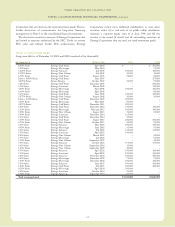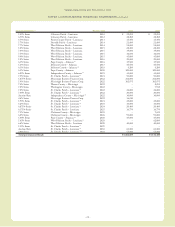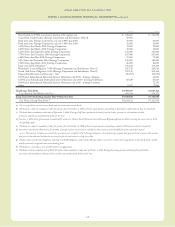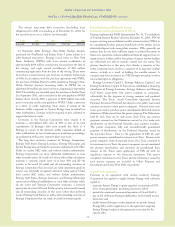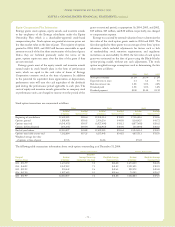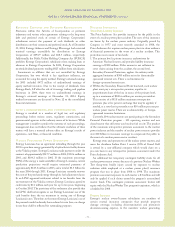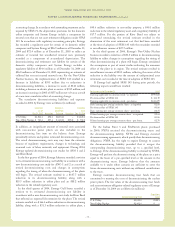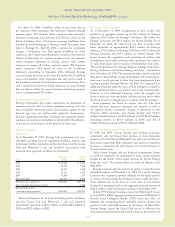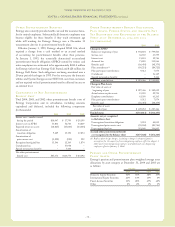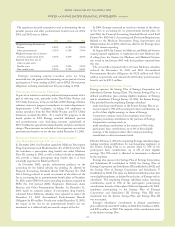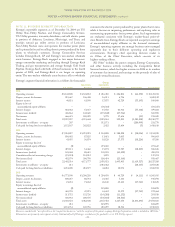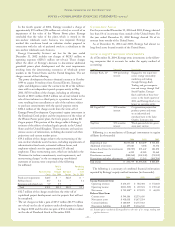Entergy 2004 Annual Report Download - page 76
Download and view the complete annual report
Please find page 76 of the 2004 Entergy annual report below. You can navigate through the pages in the report by either clicking on the pages listed below, or by using the keyword search tool below to find specific information within the annual report.
-74 -
Entergy Corporation and Subsidiaries 2004
NOTES to CONSOLIDATED FINANCIAL STATEMENTS continued
plants. These programs are underwritten by Nuclear Electric
Insurance Limited (NEIL). As of December 31, 2004, Entergy was
insured against such losses per the following structures:
U.S. Utility Plants (ANO 1 and 2, Grand Gulf 1, River Bend,
and Waterford 3)
•Primary Layer (per plant) - $500 million per occurrence
•Excess Layer (per plant) - $100 million per occurrence
•Blanket Layer (shared among all plants) - $1.0 billion
per occurrence
•Total limit - $1.6 billion per occurrence
•Deductibles:
•$5.0 million per occurrence – Turbine/generator damage
•$5.0 million per occurrence – Other than turbine/
generator damage
Note: ANO 1 and 2 share in the Primary Layer with one
policy in common.
Non-Utility Nuclear Plants (Indian Point 2 and 3, FitzPatrick,
Pilgrim, and Vermont Yankee)
•Primary Layer (per plant) - $500 million per occurrence
•Blanket Layer (shared among all plants) - $615 million
per occurrence
•Total limit - $1.115 billion per occurrence
•Deductibles:
•$1.0 million per occurrence – Turbine/generator damage
•$2.5 million per occurrence – Other than turbine/
generator damage
Note: Indian Point 2 and 3 share in the Primary Layer with one
policyin common.
In addition, the Non-Utility Nuclear plants are also covered
under NEIL’s Accidental Outage Coverage program. This
coverage provides certain fixed indemnities in the event of an
unplanned outage that results from a covered NEIL property
damage loss, subject to a deductible. The following summarizes this
coverage as of December 31, 2004:
Indian Point 2 and 3
•$4.5 million weekly indemnity
•$490 million maximum indemnity
•Deductible: 12 week waiting period
FitzPatrick and Pilgrim (each plant has an individual policy with the
noted parameters)
•$4.0 million weekly indemnity
•$490 million maximum indemnity
•Deductible: 12 week waiting period
Vermont Yankee
•$3.5 millionweekly indemnity
•$435 million maximum indemnity
•Deductible: 12 week waiting period
Entergy’s U.S. Utility nuclear plants have significantly less or no
accidental outage coverage. Under the property damage and
accidental outage insurance programs, Entergy nuclear plants could
be subject to assessments should losses exceed the accumulated
funds available from NEIL. As of December 31, 2004, the
maximum amounts of such possible assessments per occurrence
were $50.8 million for the U.S. Utility plants and $68.9 million for
the Non-Utility Nuclear plants.
Entergy maintains property insurance for its nuclear units in
excess of the Nuclear Regulatory Commission’s (NRC) minimum
requirement of $1.06 billion per site for nuclear power plant
licensees. NRC regulations provide that the proceeds of this
insurance must be used, first, to render the reactor safe and stable,
and second, to complete decontamination operations. Only after
proceeds are dedicated for such use and regulatory approval is
secured would any remaining proceeds be made available for the
benefit of plant owners or their creditors.
In the event that one or more acts of domestically-sponsored
terrorism causes property damage under one or more or all nuclear
insurance policies issued by NEIL (including, but not limited to,
those described above) within 12 months from the date the first
property damage occurs, the maximum recovery under all such
nuclear insurance policies shall be an aggregate of $3.24 billion plus
the additional amounts recovered for such losses from reinsurance,
indemnity, and any other sources applicable to such losses. There
is no aggregate limit involving one or more acts of foreign-
sponsored terrorism.
Nuclear Decommissioning and Other
Retirement Costs
SFAS 143, “Accounting for Asset Retirement Obligations,” which
was implemented effectiveJanuary1, 2003, requires the recording
of liabilities for alllegal obligations associated with the retirement
of long-lived assets that result from the normal operation of those
assets. For Entergy, these asset retirement obligations consist of its
liabilityfor decommissioning its nuclear power plants.
These liabilities are recorded at their fair values (which is the
present values of the estimated future cash outflows) in the period
in whichthey are incurred, with an accompanying addition to
the recorded cost of the long-lived asset. The asset retirement
obligation is accreted each year through a charge to expense, to
reflect the time value of money for this present value obligation.The
amounts added to the carrying amounts of the long-lived assets will
be depreciated over the useful lives of the assets. The net effect of
implementing SFAS 143 for the rate-regulated business of the
domestic utility companies and System Energy was recorded as a
regulatory asset, with no resulting impact on Entergy’s net income.
Entergy recorded these regulatory assets because existing rate
mechanisms in each jurisdiction are based on the principle
that Entergywillrecover all ultimate costs of decommissioning
from customers.
Upon implementation of SFAS 143 in 2003, assets and liabilities
increased $1.1 billion for the U.S. Utility segment as a result of
recording the asset retirement obligations at their fair values of
$1.1 billion as determined under SFAS 143, increasing utility
plant by $287 million, reducing accumulated depreciation by
$361 million, and recording the related regulatory assets of $422
million. The implementationof SFAS 143 for the portion of River
Bend not subject to cost-based ratemaking decreased earnings by
$21 million net-of-tax as a result of a one-time cumulative effect of





